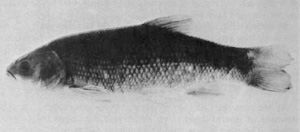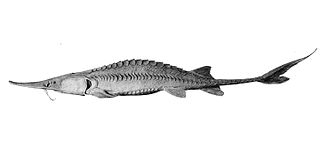
The thicktail chub was a type of minnow that inhabited the lowlands and weedy backwaters of the Sacramento and San Joaquin Rivers in the Central Valley of California. It was once abundant in lowland lakes, marshes, ponds, slow-moving stretches of river, and, during years of heavy run-off, the surface waters of San Francisco Bay. The thicktail chub was one of the most common fish in California. Within Native American middens it represented 40% of the fish.
The phantom shiner is an extinct species of fish. It was once endemic to the Rio Grande basin and ranged from central New Mexico to southernmost Texas and adjacent Tamaulipas. It was once found in the warm water reaches of the Rio Grande, though never particularly abundant. The species was last collected on 28 July 1975, in Tamaulipas, Mexico, 4.0 km below Ciudad Diaz Ordaz. Subsequent attempts to collect the phantom shiner from 1977 to 1994 were unsuccessful and it has been presumed extinct as of 1996.
The Pahranagat spinedace, ' is an extinct fish that originally inhabited the Pahranagat Valley in Nevada, United States.

The splittail, also called Sacramento splittail, is a cyprinid fish native to the low-elevation waters of the Central Valley in California. It was first described by William O. Ayres in 1854. It is the sole living member of its genus, the Clear Lake splittail P. ciscoides having become extinct in the 1970s.

The inland silverside is a neotropical silverside native to eastern North America, and introduced into California. It is a fish of estuaries and freshwater environments.

Cyprinodon is a genus of pupfishes found in waters that range from fresh to hypersaline. The genus is primarily found in Mexico, the Caribbean Islands and southern United States, but C. variegatus occurs as far north as Massachusetts and along the entire Gulf of Mexico coastline, and C. dearborni and C. variegatus are found in northern South America. Many species have tiny ranges and are highly threatened, in some cases already extinct. Cyprinodon are small; the largest reaches 10 cm (3.9 in) in length and most other species only reach about half that size.
The Clanwilliam redfin, is a ray-finned fish species in the family Cyprinidae. It is placed with the South African redfins in Pseudobarbus. It is tetraploid. Its closest living relative is probably the Twee River redfin.
The Cahaba shiner is a rare species of cyprinid fish. It is endemic to Alabama in the United States, where it is limited to the Cahaba River. It is a federally listed endangered species of the United States.
Poblana squamata, the Quechulac silverside, is a species of neotropical silverside endemic to Mexico. It was described by Jose Álvarez del Villar in 1950 from types collected from the crater lake of Quechulac which is 6.5 kilometres (4.0 mi) southeast of Alchichica, Puebla State, Mexico at and elevation of 2,365 metres (7,759 ft).

Scaphirhynchus is a genus of sturgeons native to North America. All species in this genus are considered to be threatened with extinction or worse. As of 2023, the pallid sturgeon and the Alabama sturgeon are critically endangered according to the International Union for Conservation of Nature.
The Waccamaw silverside is a rare species of fish in the family Atherinopsidae. It is a federally listed threatened species of the United States.
The Alchichica silverside is a species of neotropical silverside endemic to Lake Alchichica in Mexico.
The silverside shiner is a species of cyprinid fish. It is endemic to the southern United States and occurs in the Mobile Basin in Alabama and Mississippi. It occurs in sand-gravel runs of medium to large rivers. It lives in small schools, escaping to deeper water when disturbed. It grows to 11 cm (4.3 in) total length, although is commonly only half of that size.

The Sacramento pikeminnow, formerly known as the Sacramento squawfish, is a large cyprinid fish of California, United States. It is native to the Los Angeles River, Sacramento-San Joaquin, Pajaro-Salinas, Russian River, Clear Lake and upper Pit River river basins. It is predatory and reaches up to 1.4 m (4.6 ft) in total length.

Labidesthes sicculus, also known as the Brook silverside is a North American species of Neotropical silverside. The brook silverside lives in slow moving rivers and lakes from the Great Lakes to the Mississippi Basin and Gulf Coastal Plains. The brook silverside survives best in clear water with aquatic vegetation. L. sicculus feeds on a diet of copepods, insect larvae, and winged insects. The spawning season of the brook silverside occurs during the spring and early summer. The survival of freshwater fishes such as the brook silverside is increasingly threatened. In order to ensure survival of the brook silverside, turbidity of natural habitats should be monitored.
Chirostoma attenuatum – also known as slender silverside – was featured in the 2009 IUCN Red List of Threatened Species and the American Fisheries Society. They are found in Patzcuaro, Central Mexico. The species is at risk of being extinct. Eight helminth species, type of parasitic worms, including Posthodiplostomum minimum, Allocreadium mexicanum, Bothriocephalus acheilognathi, a cyclophyllidean cysticercoid, Arhythmorhynchus brevis, Spinitectus carolini, Capilaria patrcuarensis, and Eustrongylides sp., were discovered in 195 Chirostoma attenuatum fish from Lake Patzcuaro from October 1989 to December 1990. Posthodiplostomum minimum had the highest frequency and intensity; it had the most impact in harming the Chirostoma attenuatum fish.







